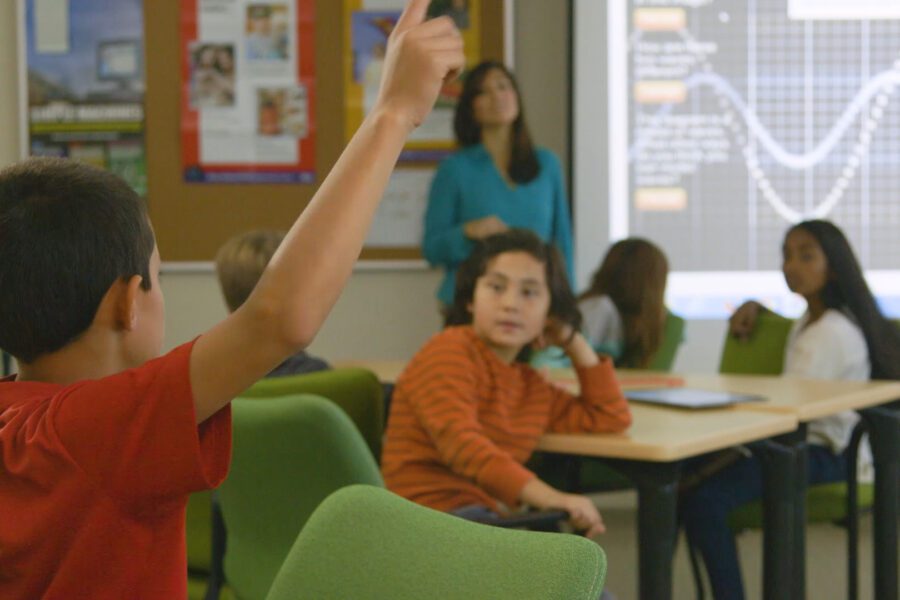
Students typically love when their teachers announce that they’re going to watch a video in class. It’s great that they are excited, but as a teacher, you have to make sure they aren’t just excited about zoning out and ignoring what they’re supposed to be learning for the entire class period. Videos can be incredible teaching tools, but it’s not enough to just stick something on a screen and let students passively watch it. We’ve pinpointed several reasons why teaching with video is beneficial for all students and some ways to maximize the effectiveness of teaching with video. We’ve also put together some of the best sources for teaching with video, as well as some specific ways to integrate videos into your lesson plans and curriculum.
Why Teaching with Video Is Beneficial
Let’s face it—school can make students bored sometimes. We know teachers are usually passionate about what they’re teaching, but oftentimes, students couldn’t care less about the Gulf War or prepositional phrases or the atmosphere of Mars. Showing a video will pique the students’ interest, if only slightly, and may introduce them to something in a way that you haven’t done. Teaching with video, more than anything, needs to help students learn more. You should identify the goal of showing them a video first, and then give them some prompts to either answer during the video or think about as they watch it. Encouraging or requiring students to respond to a video they’ve seen in class will help them actively watch the video rather than passively view it. You can also stop the video at certain times to point out something specific and model active viewing for your students.
Educational videos can take on many forms. They can be short video clips to explain in depth a particular concept, it can be a longer video that demonstrates a science experiment or the way that a particular historical battle took place, or it can be an entire lesson or lecture that essentially replaces an in-class lecture. All of these types of videos have their place in the classroom, and they all provide a number of benefits to students.
Engagement
Here at TCI, we believe in engaging students as effectively as possible so that they learn as much as they can and actually develop a love of learning in some academic subjects. One way to spice up the school day is to use videos. Students sit and listen to the same teachers talk day after day, so even if it’s just another educator presenting material in lecture format, it will engage students differently than a lecture would. If you give students prompts or questions to respond to during or after the video, they are also more likely to stay engaged and actively watch the video.
Visual Learner Benefits
Many times, visual learners struggle to grasp basic concepts because they cannot see them. Videos offer opportunities for visual learners to physically see something they’re learning about. Whether it’s a demonstration of a scientific concept or a model of a historical landmark or historical event, visual representations can hugely benefit your students. Some demonstrations are simply not possible in a normal classroom environment, but video brings real-world concepts to life and can greatly benefit your visual learners in particular.
Virtual Field Trips
Don’t have school funding to go to the planetarium? Can’t get approval to take your students to a history museum? Don’t have the time to schedule a trip to an important government building? There’s probably a video tour available. Check your local library or contact the place itself and see if they have a video that walks you through it. Video field trips like this take teaching with video to a whole new level and students not only learn something, but they tend to really enjoy experiences like these.
Handling Absences
Minimize your students missing assignments and important lectures by recording short videos of important concepts. They can access the videos online at school or from home so they don’t miss anything too important from class.
Different Ways to Integrate Teaching with Videos
Depending on how tech-savvy you are and how much you want to integrate videos into your teaching, you may wish to record all of your primary lessons or lectures on video for your students. You may want to only utilize others’ videos for use in the classroom or you may only wish to assign video watching to students for at-home completion. No matter what level of video integration you hope to achieve, there are several ways to make it happen.
Record Short Lessons
This is hugely beneficial to students, especially when they have unlimited access to the videos. Maybe you record ten 5-minute videos on the key concepts in a particular unit. Or maybe you focus on the top 15 takeaways from your class this year and record a short video segment on each. Maybe you highlight all of the most important material for an upcoming test in video form for your students to review and study more effectively. Either way, recording short videos for your students will help them learn and stay motivated and engaged. You can show these videos in class or just send your students links to them to rewatch at home if they need some extra reminders of what’s being taught in the classroom.
Have Students Watch Videos before Class
You can assign videos as homework so that students come to class with a baseline knowledge of what you’re teaching that day. You may have to quiz them on the information they learned at the start of class to ensure they actually watch the videos for homework, but doing this can lead to better discussion in class and a more thorough understanding for all students. Particularly if they know they’re expected to understand what they’re watching, they’re more likely to be actively engaged in the video.
Demonstrate Hands-On Skills
If you don’t have the space or resources to demonstrate something that you need your students to actually see, videos can save the day. Find demonstration videos on YouTube or other resources and let your students see exactly how something works or how something is done. This helps a great deal with comprehension of concepts, particularly for students who are visual learners.
Include Quizzes in Videos
You want your students to be active and engaged viewers who understand and comprehend what they’re learning. Test their ability to respond to what they’ve seen and heard with quizzes and questionnaires in the midst of videos or after completing them. This will help them watch actively, learn more, and retain more. It will also help you gauge how effective the video lessons are.
Have Students Create Videos
A popular favorite project amongst students of all ages is creating a video themselves. It can be on any subject and in any form that you wish, and it can be simple and short or long and in-depth. Encouraging digital literacy, creativity, and collaboration will serve your students well and they’ll likely have a lot of fun in the process.
Best Video Sources for Teaching
YouTube
An obvious choice of video source, YouTube has an endless collection of videos to choose from. Teachers should absolutely prescreen the entire video that they wish to show as some are higher quality than others and some have questionable material in them. Particularly for demonstrative videos or basic concept explanations, YouTube is an excellent resource. Don’t forget about TeacherTube too, where educators can share videos and use others to teach on relevant topics.
TED-Ed
Created by the founders of TedTalks, TED-Ed is focused on learning and youth education initiatives. They support teachers and students by providing a place for educators to create interactive lessons and by helping students learn presentation literacy skills and more. Another resource with seemingly endless videos, TED-Ed is a great place to start when you’re looking for educational videos or inspiration to create your own.
BBC Bitesize
Although based on educational standards in other countries, BBC Bitesize has several relevant videos and lessons available for free. They are separated by age group and subject, and all videos are short but packed with information.
Documentary Heaven
With new documentaries being added regularly, Documentary Heaven has educational videos on just about every subject imaginable. From business to arts to human rights and space, if you’re looking for a documentary, this is the place to go.
Check 123
Rated by viewers, approved by experts, and prioritized by quality, videos on Check 123 are amazing. Separated by topic and created specifically for use in education, these videos are all just a few minutes long and provide quality information that is super to educate and entertain.


